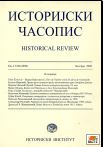Звук и грађење: примери акустичких судова из цркве манастира Давидовица
Sound and Construction: Example of Acoustic Resonators in the Church of the Davidovica Monastery
Author(s): Dejan Bulić, Dejan CrnčevićSubject(s): Archaeology
Published by: Istorijski institut, Beograd
Keywords: Serbian medieval architecture; church of the Epiphany of the Davidovica monastery; acoustic resonators; ceramic vessels
Summary/Abstract: This work presents the two examples of ceramic vessels, in function of acoustic resonators, discovered during archaeological excavation in 1997 in the church of the Epiphany of the Davidovica monastery (XIII century), immediately preceding church reconstruction. These two examples of ceramic acoustic resonators represent a rare specimen, subject to accurate dating. Terminus post quem non regarding dating is 1282, i.e. the time when the church could possilby be finished, at the earliest, according to one of the rare preserved medieval construction contracts (signed on 30th August 1281). The cited examples of acoustic resonators raise the question of correctness of scientifically employed terminology, used to designate this type of ceramic vessels. The term pot was most commonly used to designate the pottery type, accentuated by epithets earthen or special, although these vessels do not, in a strict sense, fall in that category, but can rather be classified in jugs, amphoras, or pottery intended for a specific purpose. This also raises the question of the authentic reasons that induced building practice of this kind of ceramic vessels in the structure of our medieval sacral objects, i.e. of their genuine efficiency in the light of improving the acoustic features of these buildings. Recent lab experiments on acoustic features of these ceramic acoustic resonators have shown that they, in fact, have not greatly contributed to the acoustic quality of the buildings they had been built in. Their building-in, present for a long time in Serbia (XI-XIX centuries), has thus probably represented a segment of the orally conveyed building tradition, based on the practice that was probably not grounded in knowledge of their genuine acoustic effects. Consequently, more than anything else, this practice might depict the history of mentality, that had its roots in faith, being a foundation of particular pattern of thinking, building performance, hopes and expectations.
Journal: Историјски часопис
- Issue Year: 2010
- Issue No: 59
- Page Range: 103-130
- Page Count: 28
- Language: Serbian

